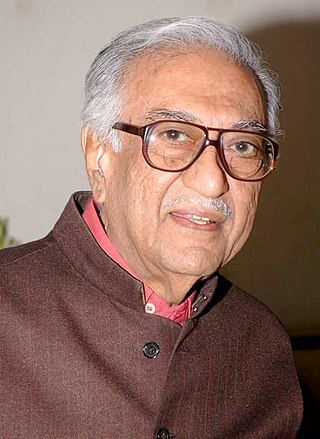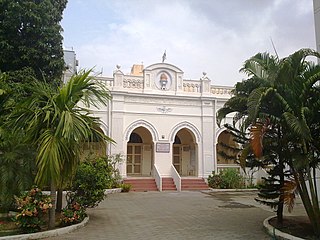Broadcasting in the city of Chennai began in 1924 by the Madras Presidency Radio Club. The service was operational till the government-run All India Radio started broadcasting in the city in 1938.
Currently, the city has 4 AM and 11 FM radio stations operated by All India Radio, Anna University and Suryan FM, Radio Mirchi, BIG FM, Hello FM, Radio City, Radio One among others. [1]
Broadcasting in India began in June 1923 during the British Raj with programmes by the Bombay Presidency Radio Club and other radio clubs. In 1924, the Madras Presidency Radio Club was established by V. Krishnaswamy Chetty. It made its first broadcast from Holloway’s Garden in Egmore on 31 July 1924. The Club later faced some financial difficulties but was rescued by the Madras Municipal Corporation in 1927, which ran it till All India Radio was established in Madras in 1938. [2] The radio station at the Ripon Building complex was founded in 1930. [3]
According to an agreement of 23 July 1927, the private Indian Broadcasting Company LTD (IBC) was authorised to operate two radio stations: the Bombay station began on 23 July 1927, and the Calcutta station followed on 26 August 1927. The company went into liquidation on 1 March 1930. The government took over the broadcasting facilities and began the Indian State Broadcasting Service (ISBS) on 1 April 1930 on an experimental basis for two years and permanently in May 1932. On 8 June 1936, the ISBS was renamed All India Radio. [4]
All India Radio Madras began its operations on 16 June 1938. It became one of the six operational stations in the AIR network in the country when India gained independence in 1947, along with Delhi, Bombay, Calcutta, Lucknow, and Tiruchirappalli. [5] The total number of radio sets at that time was about 275,000 in India. The Vividh Bharati Service was launched on 3 October 1957 to compete with Radio Ceylon. AIR Madras became the first station in the country to begin FM broadcasting on 23 July 1977, which was later expanded during the 1990s. [6]

Chennai, formerly known as Madras, is the capital city of Tamil Nadu, the southernmost Indian state. It is the state's primate city both in area and population and is located on the Coromandel Coast of the Bay of Bengal. According to the 2011 Indian census, Chennai is the sixth-most populous city in India and forms the fourth-most populous urban agglomeration. Incorporated in 1866, the Greater Chennai Corporation is the oldest municipal corporation of India and the second oldest in the world after London.

Prasar Bharati is India's state-owned Public broadcasting, headquartered in New Delhi. It is a statutory autonomous body set up by an Act of Parliament and comprises the Doordarshan Television broadcasting and Akashvani, which were earlier media units of the Ministry of Information and Broadcasting. The Parliament of India passed the Prasar Bharati Act to grant this autonomy in 1990, but it was not enacted until 15 September 1997.

Akashvani formerly known as All India Radio (AIR), officially known since 1957 as Akashvani, is the national public radio broadcaster of India and is a division of Prasar Bharati. It was established in 1936.
Arts and architecture in India have had their course shaped by a synthesis of indigenous and foreign influences that have consequently shaped the course of the arts of the rest of Asia, since ancient times. Arts refer to paintings, architecture, literature, music, dance, languages and cinema. In early India, most of the arts were derived Vedic influences. After the birth of contemporary Hinduism, Jainism, Buddhism, and Sikhism arts flourished under the patronage of kings and emperors. The coming of Islam spawned a whole new era of Indian architecture and art. Finally the British brought their own Gothic and Roman influences and fused it with the Indian style. They have a culture infusion in their art.

The Madras Presidency, or the Presidency of Fort St. George, also known as Madras Province, was an administrative subdivision (presidency) of British India. At its greatest extent, the presidency included most of southern India, including all of the Indian state of Andhra State, almost all of Tamil Nadu and some parts of Kerala, Karnataka, Odisha. The city of Madras was the winter capital of the presidency and Ooty was the summer capital. The coastal regions and northern part of Island of Ceylon at that time was a part of Madras Presidency from 1793 to 1798, when it became a separate Crown colony. Madras Presidency was neighboured by the Kingdom of Mysore on the northwest, Kingdom of Cochin on the southwest, Kingdom of Pudukkottai in the center, and the Kingdom of Hyderabad on the north. Some parts of the presidency were also flanked by Bombay Presidency (Konkan) and Central Provinces and Berar.

Ameen Sayani is a popular former radio announcer from India. He achieved fame and popularity all across the Indian Subcontinent when he presented his Binaca Geetmala program of hits over the airwaves of Radio Ceylon. He is one of the most imitated announcers even today. His style of addressing the crowd with "Behno aur Bhaiyo " as against the traditional "Bhaiyo aur Bahno" is still treated as an announcement with a melodious touch. He has produced, compered over 54,000 radio programmes and 19,000 spots/jingles since 1951.
The FM broadcasting in India began in 1977, but boomed after 2001 when the privatisation of FM broadcasting began. AIR's FM LRS was inaugurated on 1 July 2000 at 06:00 hours in Kodaikanal relaying Madurai programs in the frequency 100.5 MHz. 100.5 was so much popular and LRS was upgraded to a FM Channel in just two months. The channel covered a radius of about 200km due to its location at 2200 meters above MSL at Kodaikanal. KODAI FM, as it is popularly known. It is the biggest individual FM channel in India in both area coverage and listenership.
Binaca Geetmala was a weekly countdown show of top filmi songs from Hindi cinema. It was popular and had millions of listeners. Binaca Geetmala was broadcast on Radio Ceylon from 1952 to 1988 and then shifted to the Vividh Bharati Service of All India Radio network in 1989 where it ran until 1994. It was the first radio countdown show of Indian film songs, and has been quoted as being the most popular radio program in India during its run. Its name reflects its sponsorship by Binaca. Binaca Geetmala, and its subsequent incarnations named after Cibaca—Cibaca Sangeetmala, Cibaca Geetmala, and Colgate Cibaca Sangeetmala—ran from 1954 to 1994 on Radio Ceylon and then on Vividh Bharati. They also broadcast annual year-end lists from 1954 to 1993.
The Vividh Bharati Service of All India Radio was conceptualized to combat Radio Ceylon in 1967. Due to the Indian Government stopping its short wave relay centers, VBS is only available on the Internet. Vividh Bharati radio channel was launched on 3 October 1957.

Kasinadhuni Nageswararao, better known as Nageswara Rao Pantulu, was an Indian journalist, nationalist, politician, businessman, and a staunch supporter of Khaddar movement. He participated in the Indian independence movement and in the Indian National Congress party, including Mahatma Gandhi’s civil disobedience movement through salt satyagraha. He was conferred with the title Desabandhu by the people of Andhra Pradesh. He was a major financier of Congress activities in Andhra and Chennai and is also known for patenting Amrutanjan. He was conferred with the title Desoddhaaraka by the Andhra Mahasabha. In 1935, the Andhra University honoured him with Kalaprapoorna, an honorary doctorate of Literature.
The sport of cricket was introduced to the Indian subcontinent by sailors and traders of the English East India Company in the 17th and 18th centuries. The earliest known record of cricket in India dates from 1721 and the first club had been founded by 1792. In the 1886 and 1888 summer seasons, the Parsees cricket team toured England. In the winter of 1889–90, a team of English players was the first to tour India, followed by another in the 1892–93 season. That tour coincided with the beginning of competitive cricket in the country as the Parsees won the prestigious Bombay Presidency Match against the Europeans cricket team. By 1912–13, the tournament had become the Bombay Quadrangular with the addition of the Hindus cricket team and the Muslims cricket team. Similar tournaments began soon afterwards in Calcutta and Madras. By the end of 1918, first-class cricket was established in India.
Hyderabad, in India, has a well-developed communication and media infrastructure, and the city is covered by a large network of optical fiber cables. The city's telephone system is serviced by four landline companies: BSNL, Tata Indicom, Reliance and Airtel. There are a number of mobile-phone companies: Aircel, BSNL, Airtel, Hutch Idea Cellular, Uninor, MTS, Virgin Mobile, Tata Indicom, Tata DoCoMo and Reliance. Several companies offer broadband internet access.
The article speaks about the many print, television and radio networks that dominate Chennai city's mass media market.

Jawhar Sircar is a retired Indian Administrative Services officer, who is prominent as a public intellectual, speaker and writer. He was elected to the Rajya Sabha, the upper house of the Parliament of India, on 2 August 2021 on an AITC ticket to represent the state of West Bengal.

Sister R. S. Subbalakshmi, was a social reformer and educationist in India.

Jal Phiroj Clubwala Dar E Meher, popularly known as the Royapuram fire temple, is a Zoroastrian fire temple at Royapuram, Chennai, India. It was built in 1910 and donated to the Madras Parsi Zarthosti Anjuman by philanthropist Phiroj M. Clubwala. The temple is one of the 177 odd fire temples in the world, of which some 150 are in India. It is the only Parsi fire temple in Tamil Nadu and surrounding region, including Puducherry and Kerala. The flame in the temple is burning continuously ever since the temple was built and is stoked five times a day by the priest.

The 12615 / 12616 Grand Trunk Express is a daily Superfast Express train on Indian Railways, running between New Delhi and Chennai Central. It is a historic train and is one of the oldest trains starting services in 1929. It originally ran between Peshawar in the North West Frontier Province and Mangalore Central in the Madras Presidency. From September 2021, it runs with modern new LHB coach with revised coach position.
Radio broadcasting began in India in 1922. The Government owned radio station All India Radio dominated broadcasting since 1936 but through privatization and deregulation has allowed commercial privately owned talk and music stations to reach large audiences.

The Madras High Court is a High Court in India. It has appellate jurisdiction over the state of Tamil Nadu and the union territory of Puducherry. It is located in Chennai, and is the third oldest high court of India after the Calcutta High Court in Kolkata and Bombay High Court in Mumbai. The Madras High Court is one of four charter high courts of colonial India established in the four Presidency Towns of Madras, Bombay, Allahabad and Calcutta by letters patent granted by Queen Victoria, dated 26 June 1862. It exercises original jurisdiction over the city of Chennai, as well as extraordinary original jurisdiction, civil and criminal, under the letters patent and special original jurisdiction for the issue of writs under the Constitution of India. Covering 107 acres, the court complex is one of the largest in the world, second only to the Supreme Court of the United Kingdom.